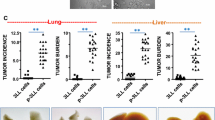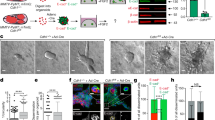Abstract
This study examined the relationship between the expression of E-cadherin or β-catenin in murine adenocarcinomas and their hematogenous metastatic propensity, assessed by both spontaneous and artificial lung metastasis. Seven different carcinomas, syngeneic to C3Hf/Kam mice were used: 4 mammary carcinomas (MCa-4, MCa-29, MCa-35, and MCa-K), ovarian carcinoma OCa-I, hepatocarcinoma HCa-I, and adenosquamous carcinoma ACa-SG. These tumors vary widely in their ability to spontaneously metastasize to the lung (from 0 to 100% metastatic incidence), and their cells greatly differ in their ability to form artificial lung nodules when injected i.v. Primary tumors in the leg were assessed for E-cadherin and β-catenin expression by western botting. The expression of both proteins showed wide variation among the tumors; however, the expression of E–cadherin correlated well with that of β-catenin. There was significant inverse correlation between the expression of E-cadherin, as well as β-catenin, and the incidence of both spontaneous and artificial lung metastases from these tumors. Spontaneous metastases of highly metastatic HCa-I and moderately metastatic MCa-35 were significantly lower in E-cadherin and β-catenin expression than their corresponding primary tumors were. Thus, the propensity of murine carcinomas for hematogenous spread is highly related to E-cadherin and β-catenin levels in primary tumors. The inverse correlation between the expression of these molecules and spontaneous and artificial metastases implies that tumor cells with low E-cadherin and β-catenin content have increased ability to enter the vascular circulation at the primary tumor site and to colonize distant tissues.
Similar content being viewed by others
References
Takeichi M. Cadherin cell adhesion receptors as a morphogenetic regulator. Science (Washington DC) 1991; 251: 1451–1455.
Kemler R. Classical cadherins. Semin Cell Biol 1992; 3: 149–155.
Boller K, Westweber D, Kemler R. Cell-adhesion molecule uvomorulin is localized in the intermediate junctions of adult intestinal epithelial cells. J Cell Biol 1985; 100: 327–332.
Nagafuchi A, Takeichi M. Cell binding function of E-cadherin is regulated by the cytoplasmic domain. EMBO J 1988; 7: 3679–3684.
Orsulic S, Peifer M. An in vivo structure-function study of Armadillo, the β-catenin homologue, reveals both separate and overlapping regions of the protein required for cell adhesion and for Wingless signaling. J Cell Biol 1996; 134: 1283–1300.
Mayer B, Johnson JP, Leitl F, Jauch KW, Heiss M, Schildberg FW, Birchmeier W, Funke I. E-cadherin expression in primary and metastatic gastric cancer: Down-regulation correlates with cellular dedifferentiation and glandular disintegration. Cancer Res 1993; 53: 1690–1695.
Frixen UH, Behrens J, Sachs M, Eberle G, Voss B, Warda A, Lochner D, Birchmeier W. E-cadherin-mediated-cell-cell adhesion prevents invasiveness of human carcinoma cells. J Cell Biol 1991; 113: 173–185.
Behrens J, Mareel MM, Van Roy FM, Birchmeier W. Dissecting tumor cell invasion: epithelial cells acquire invasive properties after the loss of uvomorulin-mediated cell-cell adhesion. J Cell Biol 1989; 108: 2435–2447.
Miyaki M, Tanaka K, Kikuchi-Yanoshita R, Muraoka K, Konishi M, Takeichi M. Increased cell-substratum adhesion, and decreased gelatinase secretion and cell growth, induced by E-cadherin transfection of human colon carcinoma cells. Oncogene 1995; 11: 2547–2552.
Oka H, Shiozaki H, Kobayashi K, Inoue M, Tahara H, Kobayashi T, Takatsuka Y, Matsuyoshi N, Hirano S, Takeichi M, Mori T. Expression of E-cadherin cell adhesion molecules in human breast cancer tissue and its relationship to metastasis. Cancer Res 1993; 53: 1696–1701.
Siitonen SM, Kononen JT, Helin HJ, Rantala IS, Holli KA, Isola JJ. Reduced E-cadherin expression is associated with invasiveness and unfavorable prognosis in breast cancer. Am J Clin Pathol 1996; 105: 394–402.
Mattijssen V, Peters HM, Schalkwijk L, Manni JJ, Hof-Grootenhoer BV, De Mulder PHM, Ruiter DJ. E-cadherin expression in head and neck squamous-cell carcinoma is associated with clinical outcome. Int J Cancer 1993; 55: 580–585.
Kadowaki T, Shiozaki H, Inoue M, Tamura S, Oka H, Doki Y, Iihara K, Matsui S, Iwazawa T, Nagafuchi A, Tsukita S, Mori T. E-cadherin and α-catenin expression in human esophageal cancer. Cancer Res 1994; 54: 291–296.
Umbas R, Isaacs WB, Bringuier PP, Schaafsma HE, Karthaus HFM, Oosterhof GON, Debruyne FMJ, Schalken JA. Decreased E-cadherin expression is associated with poor prognosis in patients with prostate cancer. Cancer Res 1994; 54: 3929–3933.
Cheng L, Nagabhushan M, Pretlow TP, Amini SB, Pretlow TG. Expression of E-cadherin in primary and metastatic prostate cancer. Am J Pathol 1996; 148: 1375–1380.
Mbalaviele G, Dunstan CR, Sasaki A, Williams PJ, Mundy GR, Yoneda T. E-cadherin expression in human breast cancer cells suppresses the development of osteolytic bone metastasis in an experimental metastasis model. Cancer Res 1996; 56: 4063–4070.
Milas L, Iwakawa M, Hunter N. Enhancement of lung colony formation by admixing irradiated with viable tumor cells: Dependence on host status. Clin Exp Metastasis 1987; 5: 213–217.
Volpe JP, Hunter N, Basic I, Milas L. Metastatic properties of murine sarcomas and carcinomas. I. Positive correlation with lung colonizationand lack of correlation with s.c. tumor take. Clin Exp Metastasis 1985; 3: 281–294.
McCarthy JB, Skubitz AP, Iida J, Mooradian DL, Wilke MS, Furcht LT. Tumor cell adhesive mechanisms and their relationship to metastasis. Sem Cancer Biol 1991; 2: 155–167.
Frost P, Levin B. Clinical implications of metastatic process. Lancet 1992; 339: 1458–1461.
Otto T, Birchmeier W, Schmidt U, Hinke A, Schipper J, Rubben H, Raz A. Inverse relation of E-cadherin and autocrine motility factor receptor expression as a prognostic factor in patients with bladder carcinomas. Cancer Res 1994; 54: 3120–3123.
Duffy MJ. Do proteases play a role in cancer invasion and metastasis? Eur J Clin Oncol 1987; 23: 583–589.
Vleminckx K, Vakaet L, Mareel M, Fiers W, Van Roy F. Genetic manipulation of E-cadherin expression by epithelial tumor cells reveals an invasion suppressor role. Cell 1991; 66: 107–119.
Birchmeier W. E-cadherin as a tumor (invasion) suppressor gene. BioEssay 1995; 17: 97–99.
Withers HR, Milas L. Influence of preirradiation of lung on development of artificial pulmonary metastases of fibrosarcoma in mice. Cancer Res 1973; 33: 1931–1936.
Nicolson GL. Organ specificity of tumor metastasis: role of preferential adhesion, invasion and growth of malignant cells at secondary organ sites. Cancer Metastasis Rev 1988; 7: 143–188.
Frixen UH, Nagamine Y. Stimulation of urokinase-type plasminogen activator expression by blockage of E-cadherin-dependent cell-cell adhesion. Cancer Res 1993; 53: 3618–3623.
Kawanishi J, Kato J, Sasaki K, Fujii S, Watanabe N, Niitsu Y. Loss of E-cadherin-dependent cell-cell adhesion due to mutation of the ß-catenin gene in a human cancer cell line, HSC-39. Mol Cell Biol 1995; 15: 1175–1181.
Vermeulen SJ, Bruyneel EA, Bracke ME, DeBruyne GK, Vennekens KM, Vleminckx KL, Berx GJ, van Roy FM, Mareel MM. Transition from the noninvasive to the invasive phenotype and loss of ß-catenin in human colon cancer cells. Cancer Res 1995; 55: 4722–4728.
Author information
Authors and Affiliations
Rights and permissions
About this article
Cite this article
Akimoto, T., Kawabe, S., Grothey, A. et al. Low E-cadherin and β-catenin expression correlates with increased spontaneous and artificial lung metastases of murine carcinomas. Clin Exp Metastasis 17, 171–176 (1999). https://doi.org/10.1023/A:1006670918848
Issue Date:
DOI: https://doi.org/10.1023/A:1006670918848




